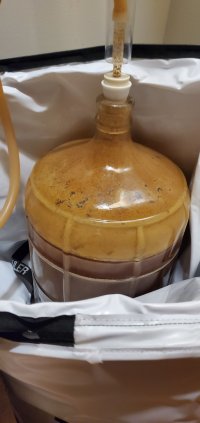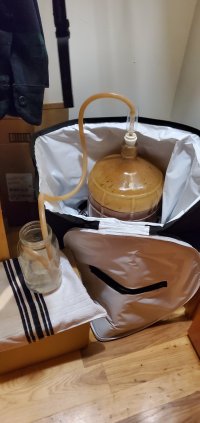melloweyelids
Member
I am fermenting my 2nd batch right now. First batch was not great, but kit was 1+ years old (except for yeast). Anyway, I have a few questions about finishing up my fermentation. Current batch is the DME More Beer Pliny Clone. OG was 1.069 and target was 1.070, which is pretty good considering that I had a mishap with the wort chiller and water leaked into the wort when cooling, adding extra water to the wort. Batch could be infected for all I know, but time will tell. I am on well water so there is no concern about chlorine. I Used Omega Yeast West Coast Ale I yeast. When the yeast arrived from More Beer it was warmish and swollen despite having two gel packs. Because of that I made a yeast starter, which I had going for 24 hours on a spin plate before pitching at 72-74°. Pitch temp and initial fermentation may have been too high. Had some krausen blowoff on Day 1 of fermentation and had to set up a blowoff tube in a large mason jar of star san. I have kept the blowoff tube on ever since. However, the carboy is quite messy with krausen residue at the moment, which leads me to my first question:
1. Is it worth racking to secondary before dry hop and cold crash so that I can avoid getting the krausen residue involved in the dry hop or transferred to the bottles when I rack? I know the general consensus is that racking to secondary is not necessary and risky in terms of oxidation, but I am wondering if the benefits might outweigh the risks in this case? Or am I overthinking it? I've also read some comments about racking to secondary being better for dry hopping to reduce the yeast interaction with the hops, but most of these comments are from 10 years ago. Thoughts?
It took 24+ hours to get the fermentation temp closer to 66°. I've kept the glass carboy in a Cool Brewing Bag (bag only) and used frozen liter bottles and gel packs to keep ferment temps around 64-66° since then. This current batch has been fermenting for 11 days. Been doing a diacetyl rest at 68-69° for the past two days. Which leads me wondering where I should go from here. I have yet to add the dry hops. For my last batch I went down the rabbit hole of how many days to dry hop and only dry hopped for two. For this batch I was planning to dry hop for 2-3 days. Which leads me to my second question:
2. How long should I dry hop for? I know some folks advocate for dry hopping right after high krausen in order to allow yeast to clean up diacetyl produced by dry hopping, while others wait until fermentation is nearly complete so there is less interaction between yeast and hops. Obviously it is too late for me to take the former option. But just looking for your thoughts regarding my current situation, and perhaps some suggestions for the future.
I did not cold crash my first batch because I was tired of going down rabbit holes. I plan to try and cold crash this time, or at least do a soft crash. I do not have a fridge or freezer to use to cold crash, so I am stuck with adding in as many frozen liter bottles as possible and seeing how it goes. Which leads me to my next question:
3. When should I cold crash? Before dry hopping or after? Again, gone down the rabbit hole and I feel like I have the answer, but want some input. It seems like the general consensus is to dry hop and then cold crash. However, my yeast is still on the sides of the carboy and I was thinking about doing a soft crash in hopes that some of the yeast falls out, dry hopping, and then cold crashing more. I am unsure what kind of cold crash temps I can get to with my current setup. Is it doing too much to cold crash twice like this? Will it even be effective in dropping some of the yeast off the sides? I know it will extend fermentation but I would be willing to try. I am also very open to other, more expedient solutions. Would love to hear your thoughts!
I've also gone down the rabbit hole about using gelatin. I ordered some from More Beer and it just arrived today. However, I've read a lot of conflicting opinions about this. Some say that using gelatin after dry hopping will reduce the hop aroma, while others say that they do not notice much of a difference. I've even read that some use less gelatin for heavily dry hopped beers like this pliny clone. So, my next questions...
4. Should I add gelatin in order to clear out this beer after cold crashing and dry hopping? Or will that ruin the extra dry hoppy aroma of my pliny clone? Again, I am sure that I am overthinking things, but I just want to fish out some opinions and input.
5. I was also considering cold crashing, adding gelatin, bringing the temp back up, then dry hopping, all before cold crashing again before racking to bottle. Is this a course to consider? I know that doing it this way would mean the gelatin would not be able to drop out the hop particles, but it might also avoid a loss of hop aroma from the gelatin. At least that is my thinking. However, this plan would be a lot of work, especially considering the fact that my current setup is pretty hodgepodge without a fridge/freezer setup for the cold crashing. Is it worth this much effort and waiting to rack for over another week to do this? Maybe not, but I want to hear your feedback.
I think these are all of the questions I have right now. I know it is a lot. And I know, I should just RDWHAHB. I am actually drinking one of the brews from my first batch right now, as mediocre as they are. Anyway, any kind of feedback would be helpful for me. There is just so much information to sift though these days, which is both a blessing and a curse. I am just looking for some help with my current batch, which will help me as I continue to home brew. Next up is a partial mash pale ale from my localish home brew shop. I digress. I appreciate your time reading, and possibly responding to, my lengthy post. Cheers.
1. Is it worth racking to secondary before dry hop and cold crash so that I can avoid getting the krausen residue involved in the dry hop or transferred to the bottles when I rack? I know the general consensus is that racking to secondary is not necessary and risky in terms of oxidation, but I am wondering if the benefits might outweigh the risks in this case? Or am I overthinking it? I've also read some comments about racking to secondary being better for dry hopping to reduce the yeast interaction with the hops, but most of these comments are from 10 years ago. Thoughts?
It took 24+ hours to get the fermentation temp closer to 66°. I've kept the glass carboy in a Cool Brewing Bag (bag only) and used frozen liter bottles and gel packs to keep ferment temps around 64-66° since then. This current batch has been fermenting for 11 days. Been doing a diacetyl rest at 68-69° for the past two days. Which leads me wondering where I should go from here. I have yet to add the dry hops. For my last batch I went down the rabbit hole of how many days to dry hop and only dry hopped for two. For this batch I was planning to dry hop for 2-3 days. Which leads me to my second question:
2. How long should I dry hop for? I know some folks advocate for dry hopping right after high krausen in order to allow yeast to clean up diacetyl produced by dry hopping, while others wait until fermentation is nearly complete so there is less interaction between yeast and hops. Obviously it is too late for me to take the former option. But just looking for your thoughts regarding my current situation, and perhaps some suggestions for the future.
I did not cold crash my first batch because I was tired of going down rabbit holes. I plan to try and cold crash this time, or at least do a soft crash. I do not have a fridge or freezer to use to cold crash, so I am stuck with adding in as many frozen liter bottles as possible and seeing how it goes. Which leads me to my next question:
3. When should I cold crash? Before dry hopping or after? Again, gone down the rabbit hole and I feel like I have the answer, but want some input. It seems like the general consensus is to dry hop and then cold crash. However, my yeast is still on the sides of the carboy and I was thinking about doing a soft crash in hopes that some of the yeast falls out, dry hopping, and then cold crashing more. I am unsure what kind of cold crash temps I can get to with my current setup. Is it doing too much to cold crash twice like this? Will it even be effective in dropping some of the yeast off the sides? I know it will extend fermentation but I would be willing to try. I am also very open to other, more expedient solutions. Would love to hear your thoughts!
I've also gone down the rabbit hole about using gelatin. I ordered some from More Beer and it just arrived today. However, I've read a lot of conflicting opinions about this. Some say that using gelatin after dry hopping will reduce the hop aroma, while others say that they do not notice much of a difference. I've even read that some use less gelatin for heavily dry hopped beers like this pliny clone. So, my next questions...
4. Should I add gelatin in order to clear out this beer after cold crashing and dry hopping? Or will that ruin the extra dry hoppy aroma of my pliny clone? Again, I am sure that I am overthinking things, but I just want to fish out some opinions and input.
5. I was also considering cold crashing, adding gelatin, bringing the temp back up, then dry hopping, all before cold crashing again before racking to bottle. Is this a course to consider? I know that doing it this way would mean the gelatin would not be able to drop out the hop particles, but it might also avoid a loss of hop aroma from the gelatin. At least that is my thinking. However, this plan would be a lot of work, especially considering the fact that my current setup is pretty hodgepodge without a fridge/freezer setup for the cold crashing. Is it worth this much effort and waiting to rack for over another week to do this? Maybe not, but I want to hear your feedback.
I think these are all of the questions I have right now. I know it is a lot. And I know, I should just RDWHAHB. I am actually drinking one of the brews from my first batch right now, as mediocre as they are. Anyway, any kind of feedback would be helpful for me. There is just so much information to sift though these days, which is both a blessing and a curse. I am just looking for some help with my current batch, which will help me as I continue to home brew. Next up is a partial mash pale ale from my localish home brew shop. I digress. I appreciate your time reading, and possibly responding to, my lengthy post. Cheers.
Attachments
Last edited:





















































![Craft A Brew - Safale BE-256 Yeast - Fermentis - Belgian Ale Dry Yeast - For Belgian & Strong Ales - Ingredients for Home Brewing - Beer Making Supplies - [3 Pack]](https://m.media-amazon.com/images/I/51bcKEwQmWL._SL500_.jpg)








